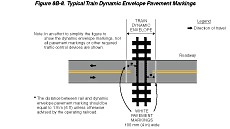Chapter 8B. Signs and Markings
Section 8B.01 Purpose
Support:
Passive traffic control systems, consisting of signs and pavement
markings, identify and direct attention to the location of a highway-rail
grade crossing and advise motorists, bicyclists, and pedestrians
to take appropriate action.
Section 8B.02 Sizes of Grade Crossing Signs
Standard:
The sizes of grade crossing signs shall be as shown in Table 8B-1.
Option:
Signs larger than those shown in Table 8B-1 may be used (see Section
2A.12).
| Sign | MUTCD Code | Section | Conventional Roads | Expressway | Minimum | Oversized |
|---|---|---|---|---|---|---|
| No Right Turn Across Tracks | R3-1a | 8B.06, 10C.09 |
600 x 750 (24 x 30) |
— | — | — |
| No Left Turn Across Tracks | R3-2a | 8B.06, 10C.09 |
600 x 750 (24 x 30) |
— | — | — |
| Do Not Stop on Tracks | R8-8 | 8B.07, 10C.05 |
600 x 750 (24 x 30) |
— | — | — |
| Tracks Out of Service | R8-9 | 8B.09, 10C.06 |
600 x 600 (24 x 24) |
— | — | — |
| Stop Here When Flashing | R8-10 | 8B.10, 10C.08 |
600 x 900 (24 x 36) |
— | — | — |
| Stop Here on Red | R10-6 | 8B.11, 10C.07 |
600 x 900 (24 x 36) |
— | — | — |
| No Turn on Red | R10-11A | 8D.07, 10C.09 |
600 x 750 (24 x 30) |
— | — | — |
| Highway-Rail Grade Crossing (Crossbuck) | R15-1 | 8B.03, 10C.02 |
1200 x 225 (48 x 9) |
— | — | — |
| Number of Tracks | R15-2 | 8B.03, 10C.02 |
675 x 450 (27 x 18) |
— | — | — |
| Exempt | R15-3 | 8B.05, 10C.10 |
600 x 300 (24 x 12) |
— | — | — |
| Light Rail Only Right Lane | R15-4a | 10C.13 | 600 x 750 (24 x 30) |
— | — | — |
| Light Rail Only Left Lane | R15-4b | 10C.13 | 600 x 750 (24 x 30) |
— | — | — |
| Light Rail Only Center Lane | R15-4c | 10C.13 | 600 x 750 (24 x 30) |
— | — | — |
| Light Rail Do Not Pass | R15-5 | 10C.14 | 600 x 750 (24 x 30) |
— | — | — |
| Do Not Pass Stopped Train | R15-5a | 10C.14 | 600 x 750 (24 x 30) |
— | — | — |
| Do Not Drive On Tracks Light Rail Symbol | R15-6 | 10C.12 | 600 x 600 (24 x 24) |
— | — | — |
| Do Not Drive On Tracks | R15-6a | 10C.12 | 600 x 750 (24 x 30) |
— | — | — |
| Light Rail Divided Highway Symbol | R15-7 | 10C.11 | 600 x 600 (24 x 24) |
— | — | — |
| Light Rail Divided Highway Symbol (T-Intersection) | R15-7a | 10C.11 | 600 x 600 (24 x 24) |
— | — | — |
| Look | R15-8 | 8B.16, 10C.03 |
900 x 450 (36 x 18) |
— | — | — |
| Highway-Rail Grade Crossing Advance Warning | W10-1 | 8B.04, 10C.15 |
900 Dia. (36 Dia.) |
— | — | — |
| Exempt | W10-1a | 8B.05, 10C.10 |
600 x 300 (24 x 12) |
— | — | — |
| Highway-Rail Grade Crossing Advance Warning | W10-2,3,4 | 8B.04, 10C.15 |
900 x 900 (36 x 36) |
— | — | — |
| Low Ground Clearance Highway-Rail Grade Crossing | W10-5 | 8B.17, 10C.16 |
900 x 900 |
— | — | — |
| Light Rail Activated Blank-out Symbol | W10-7 | 10C.17 | 600 x 600 (24 x 24) |
— | — | — |
| Trains May Exceed 130km/h (80 MPH) | W10-8 | 8B.13 | 900 x 900 (36 x 36) |
— | — | — |
| No Train Horn | W10-9 | 8B.14 | 600 x 450 (24 x 18) |
— | — | — |
| No Signal | W10-10 | 8B.15 | 600 x 450 (24 x 18) |
— | — | — |
| Storage Space symbol | W10-11 | 8B.18, 10C.18 |
900 x 900 (36 x 36) |
— | — | — |
| Storage Space XX Meters (Feet) Between Tracks & Highway | W10-11a | 8B.18, 10C.18 |
750 x 900 (30 x 36) |
— | — | — |
| Storage Space XX Meters (Feet) Between Highway & Tracks Behind You | W10-11b | 8B.18, 10C.18 |
750 x 900 (30 x 36) |
— | — | — |
| Skewed Crossing | W10-12 | 8B.19 10C.19 |
900 x 900 (36 x 36) |
— | — | — |
| No Gates or Lights | W10-13 | 8B.15 | 600 x 450 (24 x 18) |
— | — | — |
| Next Crossing | W10-14 | 8B.17 | 600 x 450 (24 x 18) |
— | — | — |
| Use Next Crossing | W10-14a | 8B.17 | 600 x 450 (24 x 18) |
— | — | — |
| Rough Crossing | W10-15 | 8B.17 | 600 x 450 (24 x 18) |
— | — | — |
| Light Rail Station symbol | I-12 | 10C.20 | 600 x 600 (24 x 24) |
— | — | — |
| Emergency Notification | I-13 | 8B.12, 10C.21 |
750 x 750 (30 x 30) |
— | — | — |
| Emergency Notification | I-13a | 8B.12, 10C.21 |
750 x 750 (30 x 18) |
— | — | — |
Notes:
- Larger signs may be used when appropriate.
- Dimensions are shown in millimeters followed by inches in parentheses and are shown as width x height.
Section 8B.03 Highway-Rail Grade Crossing (Crossbuck) Sign (R15-1) and Number of Tracks Sign (R15-2)
Standard:
The Highway-Rail Grade Crossing (R15-1) sign, commonly identified
as the Crossbuck sign, shall be retroreflectorized white with the
words RAILROAD CROSSING in black lettering, mounted as shown in
Figure 8B-1.
As a minimum, one Crossbuck sign shall be used on each highway approach to every highway-rail grade crossing, alone or in combination with other traffic control devices.
If automatic gates are not present and if there are two or more tracks at the highway-rail grade crossing, the number of tracks shall be indicated on a supplemental Number of Tracks (R15-2) sign of inverted T shape mounted below the Crossbuck sign in the manner and at the height indicated in Figure 8B-1.
Figure 8B-1 Highway-Rail Grade Crossing (Crossbuck) Regulatory Signs
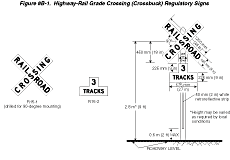
Option:
The supplemental Number of Tracks sign may also be used at highway-rail
grade crossings with automatic gates.
Standard:
The Crossbuck sign shall be installed on the right side of the highway
on each approach to the highway-rail grade crossing. Where restricted
sight distance or unfavorable highway geometry exists on an approach
to a highway-rail grade crossing, an additional Crossbuck sign shall
be installed on the left side of the highway, possibly placed back-to-back
with the Crossbuck sign for the opposite approach, or otherwise
located so that two Crossbuck signs are displayed for that approach.
A strip of retroreflective white material not less than 50 mm (2 in) in width shall be used on the back of each blade of each Crossbuck sign for the length of each blade, at all highway-rail grade crossings, except those where Crossbuck signs have been installed back-to-back.
A strip of retroreflective white material, not less than 50 mm (2 in) in width, shall be used on each support at passive highway-rail grade crossings for the full length of the front and back of the support from the Crossbuck sign or Number of Tracks sign to within 0.6 (2 ft) above the edge of the roadway, except on the side of those supports where a STOP (R1-1) or YIELD (R1-2) sign or flashing lights have been installed or on the back side of supports for Crossbuck signs installed on one-way streets.
Guidance:
Crossbuck signs should be located with respect to the highway pavement
or shoulder in accordance with the criteria in Chapter
2A and Figures 2A-1
and 2A-2,
and should be located with respect to the nearest track in accordance
with Figure 8D-2.
The minimum lateral clearance for the nearest edge of the Crossbuck sign should be 1.8 m (6 ft) from the edge of the shoulder or 3.7 m (12 ft) from the edge of the traveled way in rural areas (whichever is greater), and 0.6 m (2 ft) from the face of the curb in urban areas.
Where unusual conditions make variations in location and lateral clearance appropriate, engineering judgment should be used to provide the best practical combination of view and safety clearances.
Section 8B.04 Highway-Rail Grade Crossing Advance Warning Signs (W10 Series)
Standard:
A Highway-Rail Grade Crossing Advance Warning (W10-1) sign (see
Figure 8B-2) shall be used on each highway in advance of every highway-rail
grade crossing except in the following circumstances:
Figure 8B-2 Advance Warning Signs

- On an approach to a highway-rail grade crossing from a T-intersection with a parallel highway, if the distance from the edge of the track to the edge of the parallel roadway is less than 30 m (100 ft), and W10-3 signs are used on both approaches of the parallel highway; or
- On low-volume, low-speed highways crossing minor spurs or other tracks that are infrequently used and are flagged by train crews; or
- In business districts where active highway-rail grade crossing traffic control devices are in use; or
- Where physical conditions do not permit even a partially effective display of the sign.
Placement of the Highway-Rail Grade Crossing Advance Warning sign shall be in accordance with Chapter 2A and Table 2C-4.
Option:
On divided highways and one-way streets, an additional W10-1 sign
may be installed on the left side of the roadway.
Standard:
If the distance between the railroad tracks and a parallel highway,
from the edge of the tracks to the edge of the parallel roadway,
is less than 30 m (100 ft), W10-2, W10-3, or W10-4 signs (see Figure
8B-2) shall be installed on each approach of the parallel highway
to warn road users making a turn that they will encounter a highway-rail
grade crossing soon after making a turn, and a W10-1 sign for the
approach to the tracks shall not be required to be between the tracks
and the parallel highway.
If the W10-2, W10-3, or W10-4 signs are used, sign placement in accordance with the guidelines for Intersection Warning signs in Table 2C-4 using the speed of through traffic shall be measured from the highway intersection.
Guidance:
If the distance between the railroad tracks and the parallel highway,
from the edge of the tracks to the edge of the parallel roadway,
is 30 m (100 ft) or more, a W10-1 sign should be installed in advance
of the highway-rail grade crossing, and the W10-2, W10- 3, or W10-4
signs should not be used on the parallel highway.
Section 8B.05 EXEMPT Highway-Rail Grade Crossing Signs (R15-3, W10-1a)
Option:
When authorized by law or regulation, a supplemental EXEMPT (R15-3)
sign (see Figure 8B-3) with a white background bearing the word
EXEMPT may be used below the Crossbuck sign or Number of Tracks
sign, if present, at the highway-rail grade crossing, and a supplemental
EXEMPT (W10-1a) sign (see Figure 8B-5)
with a yellow background bearing the word EXEMPT may be used below
the Highway-Rail Advance Warning (W10-1) sign.
Figure 8B-3 Regulatory Signs
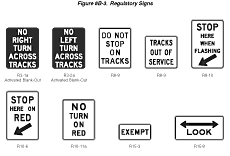
Support:
These supplemental signs inform drivers of vehicles carrying passengers
for hire, school buses carrying students, or vehicles carrying hazardous
materials that a stop is not required at certain designated highway-rail
grade crossings, except when a train, locomotive, or other railroad
equipment is approaching or occupying the highway-rail grade crossing,
or the driver's view is blocked.
Section 8B.06 Turn Restrictions During Preemption
Guidance:
At a signalized intersection that is located within 60 m (200 ft)
of a highway-rail grade crossing, measured from the edge of the
track to the edge of the roadway, where the intersection traffic
control signals are preempted by the approach of a train, all existing
turning movements toward the highway-rail grade crossing should
be prohibited during the signal preemption sequences.
Option:
A blank-out or changeable message sign and/or appropriate highway
traffic signal indication or other similar type sign may be used
to prohibit turning movements toward the highway-rail grade crossing
during preemption. The R3-1a and R3-2a signs shown in Figure
8B-3 may be used for this purpose.
Standard:
Turn prohibition signs that are associated with preemption shall
be visible only when the highway-rail grade crossing restriction
is in effect.
Section 8B.07 DO NOT STOP ON TRACKS Sign (R8-8)
Guidance:
Whenever engineering judgment determines that the potential for
vehicles stopping on the tracks is high, a DO NOT STOP ON TRACKS
(R8-8) sign (see Figure 8B-3) should be used.
The sign, if used, should be located on the right side of the highway on either the near or far side of the highway-rail grade crossing, depending upon which side provides better visibility to approaching drivers.
Option:
DO NOT STOP ON TRACKS signs may be placed on both sides of the track.
On divided highways and one-way streets, a second DO NOT STOP ON TRACKS sign may be placed on the near or far left side of the highway-rail grade crossing to further improve visibility of the sign.
Section 8B.08 STOP (R1-1) or YIELD (R1-2) Signs at Highway-Rail Grade Crossings
Option:
At the discretion of the responsible State or local highway agency,
STOP (R1-1) or YIELD (R1-2) signs (see Figure
2B-1) may be used at highway-rail grade crossings that have
two or more trains per day and are without automatic traffic control
devices.
Support:
Two or more trains per day means an average of two or more trains
per day operating over the highway-rail grade crossing for a 12-month
period prior to the installation of the STOP or YIELD control sign.
Option:
For other highway-rail grade crossings with passive warning devices,
STOP or YIELD signs may be used based on an engineering study.
Guidance:
The engineering study should take into consideration such factors
as highway and train traffic characteristics (including volume and
speed), collision history, the need for active control devices,
and sight distance to the approaching train.
Option:
If a STOP or YIELD sign is installed at a highway-rail grade crossing,
it may be installed on the Crossbuck post or on a separate post
at a point where the vehicle is to stop, or as near to that point
as practical.
Standard:
For all highway-rail grade crossings where STOP or YIELD signs are
installed, the placement shall conform to the requirements of Sections
2B.06
and 2B.10.
Stop Ahead (W3-1) or Yield Ahead (W3-2) Advance Warning signs (see
Figure 2C-4) shall also
be installed if the criteria for their installation given in Section
2C.29 is met.
Section 8B.09 TRACKS OUT OF SERVICE Sign (R8-9)
Option:
The TRACKS OUT OF SERVICE (R8-9) sign (see Figure
8B-3) may be used at a highwayrail grade crossing instead of
a Crossbuck (R15-1) sign and a Number of Tracks (R15-2) sign (see
Figure 8B-1) when railroad tracks have
been temporarily or permanently abandoned, but only until such time
that the tracks are removed or paved over.
Standard:
When tracks are out of service, traffic control devices and gate
arms shall be removed and the signal heads shall be removed or hooded
or turned from view to clearly indicate that they are not in operation.
The R8-9 sign shall be removed when the tracks have been removed or covered or when the highway-rail grade crossing is returned to service.
Section 8B.10 STOP HERE WHEN FLASHING Sign (R8-10)
Option:
The STOP HERE WHEN FLASHING (R8-10) sign (see Figure 8B-3) may be
used at a highway-rail grade crossing to inform drivers of the location
of the stop line or the point at which to stop when the flashing-light
signals (see Section 8D.02)
are activated.
Section 8B.11 STOP HERE ON RED Sign (R10-6)
Support:
The STOP HERE ON RED (R10-6) sign (see Figure 8B-3) defines and
facilitates observance of stop lines at traffic control signals.
Option:
A STOP HERE ON RED sign may be used at locations where vehicles
frequently violate the stop line or where it is not obvious to road
users where to stop.
Guidance:
If possible, stop lines should be placed at a point where the vehicle
driver has adequate sight distance along the track.
Section 8B.12 Emergency Notification Sign (I-13 or I-13a)
Guidance:
An Emergency Notification (I-13 or I-13a) sign (see Figure
8B-4) should be installed at all highway-rail grade crossings
to provide for emergency notification. The sign should have a white
message on blue background.
Location and placement should be decided cooperatively by the railroad company and the public or private highway agencies based on specific site conditions. However, these signs are typically located on the railroad right-of-way.
This sign, which is for emergency notification, should convey a clear and simple message that is visible to anyone stalled or disabled on the railroad tracks, and to anyone with other emergencies.
Support:
Examples of sign messages are shown in Figure 8B-4.
Figure 8B-4 Emergency Notification Signs

Section 8B.13 TRAINS MAY EXCEED 130 km/h (80 MPH) Sign (W10-8)
Guidance:
Where trains are permitted to travel at speeds exceeding 130 km/h
(80 mph), a TRAINS MAY EXCEED 130 km/h (80 MPH) (W10-8) sign (see
Figure 8B-5) should be installed facing road users approaching the
highway-rail grade crossing.
Figure 8B-5 Warning Signs
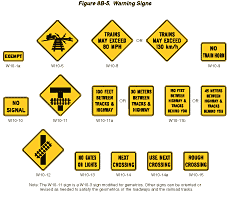
If used, the TRAINS MAY EXCEED 130 km/h (80 MPH) signs should be installed between the Highway-Rail Grade Crossing Advance Warning (W10-1) sign (see Figure 8B-2) and the highway-rail grade crossing on all approaches to the highway-rail grade crossing. The locations should be determined based on specific site conditions.
Section 8B.14 NO TRAIN HORN Sign (W10-9)
Standard:
A NO TRAIN HORN (W10-9) sign (see Figure 8B-5) shall be installed
at each highway-rail grade crossing where there is a Federal Railroad
Administration authorization for trains to not sound a horn. The
sign shall be mounted as a supplemental plaque below the Highway-Rail
Grade Crossing Advance Warning (W10-1) sign (see Figure 8B-2).
Section 8B.15 NO SIGNAL Sign (W10-10) or NO GATES OR LIGHTS Sign (W10-13)
Option:
A NO SIGNAL (W10-10) sign or a NO GATES OR LIGHTS (W10-13) sign
(see Figure 8B-5) may be installed at highway-rail
grade crossings that are not equipped with automated signals.
The NO SIGNAL (W10-10) sign or the NO GATES OR LIGHTS (W10-13) sign may be mounted as a supplemental plaque below the Advance Warning (W10-1) sign.
Section 8B.16 LOOK Sign (R15-8)
Option:
At highway-rail grade crossings, the LOOK (R15-8) sign (see Figure
8B-3) may be mounted as a supplemental plaque on the Crossbuck
(R15-1) sign post, or as a separate sign in the immediate vicinity
of the highway-rail grade crossing on the railroad right-of-way.
Section 8B.17 Low Ground Clearance Highway-Rail Grade Crossing Sign (W10-5)
Guidance:
If the highway profile conditions are sufficiently abrupt to create
a hang-up situation for long wheelbase vehicles or for trailers
with low ground clearance, the Low Ground Clearance Highway-Rail
Grade Crossing (W10-5) sign (see Figure 8B-5)
should be installed in advance of the highway-rail grade crossing.
Standard:
Because this symbol might not be readily recognizable by the public,
the Low Ground Clearance Highway-Rail Grade Crossing (W10-5) warning
sign shall be accompanied by an educational plaque, LOW GROUND CLEARANCE.
The LOW GROUND CLEARANCE educational plaque shall remain in place
for at least 3 years after the initial installation of the W10-5
sign (see Section 2A.13).
Guidance:
Auxiliary plaques such as AHEAD, NEXT CROSSING, USE NEXT CROSSING
(with appropriate arrows), or a supplemental distance plaque should
be placed below the W10-5 sign at the nearest intersecting highway
where a vehicle can detour or at a point on the highway wide enough
to permit a U-turn.
If engineering judgment of roadway geometric and operating conditions confirms that vehicle speeds across the railroad tracks should be below the posted speed limit, a W13-1 advisory speed plaque should be posted.
Option:
If the highway-rail grade crossing is rough, word message signs
such as BUMP, DIP, or ROUGH CROSSING may be installed. A W13-1 advisory
speed plaque may be installed below the word message sign in advance
of rough crossings.
Support:
Information on railroad ground clearance requirements is also available
in the "American Railway Engineering and Maintenance-of-Way
Association’s Engineering Manual," or the American Association
of State Highway and Transportation Officials’ "Policy
on Geometric Design of Highways and Streets" (see Section
1A.11).
Section 8B.18 Storage Space Signs (W10-11, W10-11a, W10-11b)
Guidance:
A Storage Space (W10-11) sign supplemented by a word message storage
distance (W10-11a) sign (see Figure 8B-5) should be used where there
is a highway intersection in close proximity to the highway-rail
grade crossing and an engineering study determines that adequate
space is not available to store a design vehicle(s) between the
highway intersection and the train dynamic envelope.
The Storage Space (W10-11 and W10-11a) signs should be mounted in advance of the highway-rail grade crossing at an appropriate location to advise drivers of the space available for vehicle storage between the highway intersection and the highway-rail grade crossing.
Option:
A Storage Space (W10-11b) sign (see Figure 8B-5) may be mounted
beyond the highwayrail grade crossing at the highway intersection
under the STOP or YIELD sign or just prior to the signalized intersection
to remind drivers of the storage space between the tracks and the
highway intersection.
Section 8B.19 Skewed Crossing Sign (W10-12)
Option:
The Skewed Crossing (W10-12) sign (see Figure 8B-5) may be used
at a skewed highway-rail grade crossing to warn drivers that the
railroad tracks are not perpendicular to the highway.
Guidance:
If the Skewed Crossing sign is used, the symbol should show the
direction of the crossing (near left to far right as shown in Figure
8B-5, or the mirror image if the track goes from far left to near
right). If the Skewed Crossing sign is used where the angle of the
crossing is significantly different than 45 degrees, the symbol
should show the appropriate angle of the crossing.
Standard:
The Skewed Crossing sign shall not be used as a replacement for
the required Advance Warning (W10-1) sign. If used, the Skewed Crossing
sign shall supplement the W10-1 sign and shall be mounted on a separate
post.
Section 8B.20 Pavement Markings
Standard:
All highway-rail grade crossing pavement markings shall be retroreflectorized
white. All other markings shall be in accordance with Part
3.
Pavement markings in advance of a highway-rail grade crossing shall consist of an X, the letters RR, a no-passing marking (two-lane highways where centerline markings are used), and certain transverse lines as shown in Figures 8B-6 and 8B-7.
Figure 8B-6 Example of Placement of Warning Signs and Pavement Markings at Highway-Rail Grade Crossings
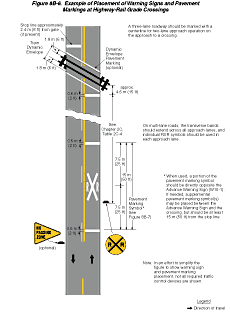
Figure 8B-7 Examples of Highway-Rail Grade Crossing Pavement Markings
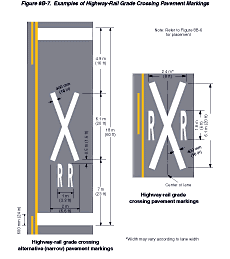
Identical markings shall be placed in each approach lane on all paved approaches to highway-rail grade crossings where signals or automatic gates are located, and at all other highway-rail grade crossings where the posted or statutory highway speed is 60 km/h (40 mph) or greater.
Pavement markings shall not be required at highway-rail grade crossings where the posted or statutory highway speed is less than 60 km/h (40 mph), or in urban areas, if an engineering study indicates that other installed devices provide suitable warning and control.
Guidance:
When pavement markings are used, a portion of the X symbol should
be directly opposite the Advance Warning sign. The X symbol and
letters should be elongated to allow for the low angle at which
they will be viewed.
Option:
When justified by engineering judgment, supplemental pavement marking
symbol(s) may be placed between the Advance Warning sign and the
highway-rail grade crossing.
Section 8B.21 Stop Lines
Guidance:
The stop line should be a transverse line at a right angle to the
traveled way at a point where a vehicle is to stop or as near to
that point as possible. The stop line should be placed approximately
2.4 m (8 ft) from the gate (if present), but no closer than 4.6
m (15 ft) from the nearest rail.
Section 8B.22 Dynamic Envelope Markings
Option:
Dynamic envelope markings may be used to mark the edges of the dynamic
envelope where there is a highway intersection in close proximity
to the highway-rail grade crossing and an engineering study determines
that vehicles might stop within the dynamic envelope area.
Dynamic envelope markings may be installed at all highway-rail grade crossings, unless a Four-Quadrant Gate system (see Section 8D.05) is used.
Standard:
If used, pavement markings for indicating the dynamic envelope shall
conform to Part 3 and shall be a 100 mm (4 in) normal solid white
line or contrasting pavement color and/or contrasting pavement texture.
Guidance:
If used, dynamic envelope pavement markings should be placed on
the highway 1.8 m (6 ft) from the nearest rail, installed parallel
to the tracks, unless the operating railroad company advises otherwise.
The pavement markings should extend across the roadway as shown
in Figure 8B-8.
Figure 8B-8 Typical Train Dynamic Envelope Pavement Markings
